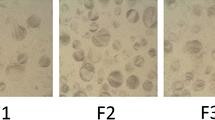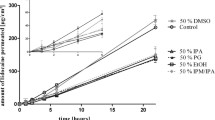Abstract
Purpose
To measure in vitro release of taurine from a semisolid standard formulation (amphiphilic cream, DAC) containing 1% taurine, a multi-layer membrane system was used. The content and distribution of taurine in different healthy skin layers (stratum corneum, epidermis and dermis) before (native taurine) and after application of the DAC cream were determined using capillary electrophoresis.
Methods
The release of taurine from the DAC cream was studied using a multilayer membrane system. Due to the high hydrophilic properties of taurine, the artificial model membranes consisted of collodion as matrix and glycerol as the acceptor phase. In order to determine whether taurine shows the potential for dermal penetration a Franz diffusion cell system was used. The distribution of taurine in the skin layers was determined before and after application of the DAC cream followed by the incubation in a Franz diffusion cell. The excised skin sample was cut in horizontal sections using a cryomicrotome. In order to detect taurine, fluorescamine was used as a derivatization agent.
Results
Experiments with a multilayer membrane system were performed to verify the release of taurine at different times (1, 2 and 5 h). Approximately 42.5% taurine was released from the semisolid standard formulation, accumulating in the first membrane (17.63%). The native taurine content was quantified in human isolated skin layer before and after the application of the semisolid standard formulation followed by incubation in a Franz-type diffusion cell for 1 and 5 h. No statistically significant difference (p < 0.05) of the taurine content in the skin layers existed between exposure times (1 and 5 h) studied. The highest taurine content was found in the epidermis both before (256.01 μg taurine/g skin layer) and after (555.5 μg taurine/g skin layer) the application of the DAC cream.
Conclusions
The distribution profile of taurine in the skin layers was very similar for the times studied, which suggests that taurine is accumulated in specific cells of the skin. The study suggests that taurine is effectively released from the semisolid standard formulation and can be used for topical application in dermatopharmaceutics.




Similar content being viewed by others
References
A. Albert. Quantitative studies of the avidity of naturally occurring substances for trace metal. I. Amino acids having only two ionizing groups. Biochem. J. 47:531–535 (1950).
J. D. Madura, J. B. Lombardini, J. M. Briggs, D. L. Minor, and A. Wierzbicki. Physical and structural properties of taurine and taurine analogues. Amino Acids. 13:131–139 (1997).
R. J. Huxtable. Physiological actions of taurine. Physiol. Rev. 72:101–163 (1992).
B. Anderheggen, C. Jassoy, M. Waldmann-Lane, T. Forste, A. Wadler, and T. Doering. Taurine improves epidermal barrier properties stressed by surfactants—a role for osmolytes in barrier homeostasis. Int. J. Cosmet. Sci. 28:386–387 (2006).
H. Watanabe, M. Watanabe, N. Jo, K. Kiyokane, and M. Shimada. Distribution of [1,2-3H]taurine in the skin of adult and newborn mice studied by microradioautography. Cell. Mol. Biol. 41:49–55 (1995).
G. Janeke, W. Siefken, S. Carstensen, G. Springmann, O. Bleck, H. Steinhart, P. Höger, K. P. Wittern, H. Wenck, F. Stäb, G. Sauermann, V. Schreiner, and T. Doering. Role of taurine accumulation in keratinocyte hydration. J. Invest. Dermatol. 121:354–361 (2003).
F. Grafe, W. Wohlrab, R. H. Neubert, and M. Brandsch. Functional characterization of sodium- and chloride-dependent taurine transport in human keratinocytes. Eur. J. Pharm. Biopharm. 57:337–341 (2004).
C. Collin, B. Gautier, O. Gaillard, P. Hallegot, S. Chabane, P. Bastien, M. Peyron, M. Bouleau, S. Thibaut, F. Pruche, A. Duranton, and B. A. Bernard. Protective effects of taurine on human hair follicle grown in vitro. Int. J. Cosmet. Sci. 28:289–298 (2006).
M. V. T. Lobo, F. J. M. Alonso, A. Latorre, and R. M. Rio. Taurine levels and localization in the stratified squamous epithelia. Histochem. Cell Biol. 115:341–347 (2001).
H. Högstrom. Mechanism and prevention of decrease in wound margin strength. Acta Chir. Scand. 539:5–63 (1987).
S. T. Bergren, J. H. Bodzin, and J. A. Cortes. Improved survival using oxygen free radical scavengers in the presence of ischemic bowel anastomosis. Am. Surg. 54:333–336 (1988).
S. Dinçer, A. Babül, D. Erdoğan, C. Özoğul, and S. L. Dinçer. Effect of taurine on wound healing. Amino Acids. 10:59–71 (1996).
Z. Değim, N. Çelebi, H. Sayan, A. Babül, D. Erdoğan, and G. Take. An investigation on skin wound healing in mice with a taurine–chitosan gel formulation. Amino Acids. 22:187–198 (2002).
R. H. H. Neubert, and W. Wohlrab. In vitro methods for the biopharmaceutical evaluation of topical formulations. Acta Pharm. Technol. 36:197–206 (1990).
R. H. H. Neubert, C. Bendas, W. Wohlrab, B. Gienau, and W. Fürst. A multilayer membrane system for modelling drug penetration into skin. Int. J. Pharm. 75:89–94 (1991).
R. H. H. Neubert, K. Winter, and B. Bendas. Bestimmung der Arzneistoffverfügbarkeit aus kommerziellen topischen Zubereitungen mit dem Mehrschichtmembranmodell. Pharmazie. 48:54–56 (1993).
R. H. H. Neubert, W. Wohlrab, and C. Bendas. Modelling of drug penetration into human skin using a multulayer membrane system. Skin Pharmacol. 8:119–129 (1995).
T. J. Franz. Percutaneous absorption. On the relevance of in vitro data. J. Invest. Dermatol. 64:190–195 (1975).
Neues Rezeptur-Formularium (NRF). Bundesvereinigung Deutscher Apoteker Verbände. Govi, Eschborn, 2005.
B. Bendas, U. Schmalfuß, and R. H. H. Neubert. Influence of propylene glycol as cosolvent on mechanisms of drug transport from hydrogels. Int. J. Pharm. 116:19–30 (1995).
I. P. Dick, and R. C. Scott. Pig ear skin as an in-vitro model for human skin permeability. J. Pharm. Pharmacol. 44:640–645 (1992).
K. Moser, K. Kriwet, A. Naik, Y. N. Kalia, and R. H. Guy. Passive skin penetration enhancement and its quantification in vitro. Eur. J. Pharm. Biopharm. 52:103–112 (2001).
I. M. Schneider, B. Dobner, R. Neubert, and W. Wohlrab. Evaluation of drug penetration into human skin ex vivo using branched fatty acids and propylene glycol. Int. J. Pharm. 145:187–196 (1996).
H. Wagner, K. H. Kostka, C. M. Lehr, and U. F. Schaefer. Drug distribution in human skin using two different in vitro test systems: comparison with in vivo data. Pharm. Res. 17:1475–1481 (2000).
Author information
Authors and Affiliations
Corresponding author
Rights and permissions
About this article
Cite this article
da Silva, D.L.P., Thiago, S.B., Pessôa, F.A. et al. Penetration Profile of Taurine in the Human Skin and Its Distribution in Skin Layers. Pharm Res 25, 1846–1850 (2008). https://doi.org/10.1007/s11095-008-9589-0
Received:
Accepted:
Published:
Issue Date:
DOI: https://doi.org/10.1007/s11095-008-9589-0




